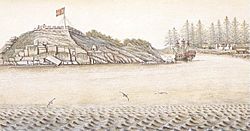Fort San Miguel facts for kids
Quick facts for kids Fort San Miguel |
|
|---|---|
| Yuquot, Nootka Island, near Vancouver Island, British Columbia, Canada | |

Depiction of Fort San Miguel, 1793
|
|
| Coordinates | 49°35′30″N 126°36′56″W / 49.59163°N 126.615458°W |
| Type | fortification, colony |
| Site information | |
| Controlled by | Spanish |
| Site history | |
| Built | 1789 |
| In use | 1789–1795 |
| Garrison information | |
| Past commanders |
Pedro de Alberni |
| Garrison | Free Company of Volunteers of Catalonia, First Company |
Fort San Miguel was a Spanish fort built on Nootka Island. This island is located just west of north-central Vancouver Island in British Columbia. The fort was made to protect a Spanish settlement called Santa Cruz de Nuca. This settlement was the first European colony in what is now British Columbia.
Contents
History of Fort San Miguel
Building the First Fort
The fort was first built in 1789 by a Spanish explorer named Esteban José Martínez. He chose a spot on Hog Island, at the entrance of Friendly Cove. Workers quickly built places for cannons, soldiers' homes, and a powder room. On June 24, 1789, the Spanish fired their cannons. This showed they were taking control of Nootka Harbour.
American ships were also in the harbour. Their captains, Robert Gray and John Kendrick, celebrated their own country's independence. The Spanish fort also fired its cannons to join the celebration.
Abandoning and Rebuilding
Later in 1789, new orders came from Viceroy Flores. He was a very important Spanish official. The orders said to leave the fort. So, Martínez took the cannons and left on October 30, 1789. The fort was taken apart. But Martínez hoped to come back. He buried bricks and lime for future building.
One year later, in 1790, the fort was rebuilt. A Spanish army captain named Pedro de Alberni led this effort. He came with 80 soldiers. They sailed with an expedition led by Francisco de Eliza.
When they arrived, Eliza set up three ways to defend the area. These included a large ship, soldiers on land, and rebuilding the fort on San Miguel Island. Building the fort was hard work. It was on a tall, rocky island. They had to build special openings for the cannons. It took four days to put eight large cannons in place. Later, six smaller cannons were also added.
Life at the Fort
The fort was near the home of Maquinna. He was the chief of the Mowachaht people. Today, the Mowachaht are part of the Mowachaht/Muchalaht First Nations. They live near Gold River on Vancouver Island.
Leaving the Fort
The Spanish soldiers left the fort in 1792. In 1795, the fort was finally abandoned. This happened because of an agreement called the third Nootka Convention. Before the Spanish built the fort, the area was the summer village of Yuquot for the Mowachaht people.
After the Spanish left, the Mowachaht people, led by Chief Maquinna, moved back. Even years later, in 1803-1805, parts of the Spanish fort were still visible. This was noted by John R. Jewitt, an English person who lived there as a captive of Maquinna.
See also
 In Spanish: Fuerte de San Miguel de Nutca para niños
In Spanish: Fuerte de San Miguel de Nutca para niños

